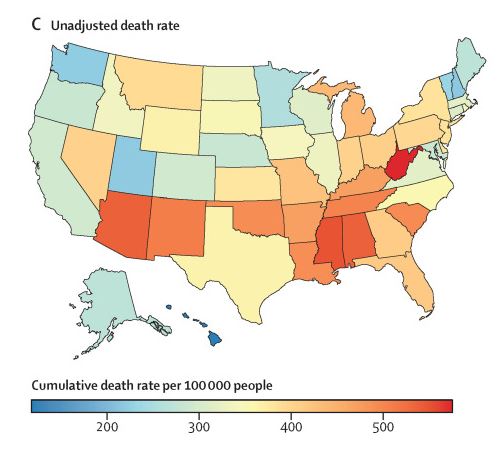A major study has singled out New Hampshire as a model among U.S. states in response to COVID-19, having suffered virtually the lowest cumulative death rate from the pandemic.
The state’s success, the study said, came about partly because of relative wealth, partly from lack of racial and ethnic groups that were harder hit by the disease, partly “by being more aggressive than most states in addressing its social and racial disparities” for vaccines, and partly because of public trust.
“New Hampshire also reports the nation’s highest levels of interpersonal trust—the trust that people have in one another—that makes it easier to mobilize against a pandemic,” wrote an article in the publication ThinkGlobalHealth from the Council on Foreign Relations, which ran the study along with the Institute for Health Metrics and Evaluation.
Only Hawaii, which as an island could better control infection-carrying arrivals, had a lower COVID death rate than the Granite State.
The study, published in the British medical journal Lancet, says that if all states had done as well as New Hampshire in limiting COVID deaths, the country would have had 505,624 fewer deaths between January 1, 2020, and July 31, 2022, a difference of more than 40 percent.
Overall, the United States did poorly compared to other rich nations in terms of protecting its citizens from the pandemic, reporting some of the world’s highest COVID-19 death rates and confirmed SARS-CoV-2 infection rates in every year of the pandemic. The ThinkGlobalHealth story says Mississippi, West Virginia and Arizona had death rates similar to the worst-hit countries in the world, Peru, Bulgaria and Russia.
During the period in question New Hampshire had 218 deaths from COVID per 100,000 people, compared to the national figure of 372. It was the second-best result both in number of deaths and also when adjusted for discrepancies between states in comorbidities, a common practice in public health analysis.
Vermont and Maine also had relatively low death counts, both being in the top 10 states for pure death count and just behind New Hampshire when adjusted for comorbidities. Massachusetts, with 317 deaths per 100,000, was in the middle of the pack among states.
“New Hampshire’s example demonstrates that the most important lessons from this pandemic are not about protective countermeasures, but instead what COVID-19 revealed about the communities that deploy such measures,” the ThinkGlobalHealth article states” The U.S. failure to learn that lesson helps explain why the United States continues to have among the worst COVID-19 mortality rates in the world, despite the arrival of effective vaccines, having an ample and early supply of doses, and the election of a new U.S. president.”
The Lancet study can be seen at https://www.thelancet.com/journals/lancet/article/PIIS0140-6736(23)00461-0/fulltext#seccestitle150
The ThinkGlobalHealth article can be seen at https://www.thinkglobalhealth.org/article/not-all-us-states-struggled-equally-against-covid-19


 Return to the Concord Monitor
Return to the Concord Monitor
It would be interesting to see the death rates plotted against population density, portion of the population working in “essential” occupations (and therefore continuing to work through the pandemic), and percentage of population that attends church regularly (as many outbreaks were associated with congregations that refused to cancel services).
New Hampshire is remarkably unchurched, doesn’t have a lot of essential manufacturing as a percent of the population, and has a relatively low population density.
Looking at ethnic and economic variables one at a time is all well and good, but a principal components analysis would be good to do to see which variable actually contributes most to the correlation with Covid deaths.
New Hampshire is also well connected via family ties and social media. Early information circulated regarding masking data from Covid Sars 1 in other countries made a difference.
As doctors and nurses know effective masks are still the best protection from infectious respiratory diseases. Distance or shields is the next best protection. Those who say it has been proven that masks don’t work are lying or stupid. The data is out there and is easy to access.
What helped was a more positive attitude towards wearing protective masks ! I am sorry to see more folks without masks these days in areas of large crowds !!